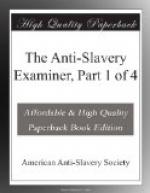January 14, 1822. Mr. Rhea, of Tennessee, presented a memorial of citizens of that state, praying “that provision may be made, whereby all slaves which may hereafter be born in the District of Columbia, shall be free at a certain period of their lives.” Journal H.R. 1821-22, p. 142.
December 13, 1824. Mr. Saunders of North Carolina, presented a memorial of citizens of that state, praying “that measures may be taken for the gradual abolition of slavery in the United States.” Journal H.R. 1824-25, p. 27.
December 16, 1828. “Mr. Barnard presented the memorial of the American Convention for promoting the abolition of slavery, held in Baltimore, praying that slavery may be abolished in the District of Columbia.” Journal U.S. Senate, 1828-29, p. 24.
6. Distinguished statesmen and jurists in the slaveholding states, have conceded the power of Congress to abolish slavery in the District. The testimony of Messrs. Doddridge, Powell, and Alexander, of Virginia, Chief Justice Cranch, and Judges Morsell and Van Ness, of the District, has already been given. In the debate in Congress on the memorial of the Society of Friends, in 1790, Mr. Madison, in speaking of the territories of the United States, explicitly declared, from his own knowledge of the views of the members of the convention that framed the constitution, as well as from the obvious import of its terms, that in the territories “Congress have certainly the power to regulate the subject of slavery.” Congress can have no more power over the territories than that of “exclusive legislation in all cases whatsoever,” consequently, according to Mr. Madison, “it has certainly the power to regulate the subject of slavery in the” District. In March, 1816, John Randolph introduced a resolution for putting a stop to the domestic slave trade within the District. December 12, 1827, Mr. Barney, of Maryland, presented a memorial for abolition in the District, and moved that it be printed. Mr. McDuffie, of South Carolina, objected to the printing, but “expressly admitted the right of Congress to grant to the people of the District any measures which they might deem necessary to free themselves from the deplorable evil.”—(See letter of Mr. Claiborne, of Mississippi, to his constituents, published in the Washington Globe, May 9, 1836.) The sentiments of Henry Clay on the subject are well known. In a speech before the U.S. Senate, in 1836, he declared the power of Congress to abolish slavery in the District “unquestionable.” Messrs. Blair, of Tennessee, Chilton, Lyon, and Richard M. Johnson, of Kentucky, A.H. Shepperd, of North Carolina, Messrs. Armstrong and Smyth, of Virginia, Messrs. Dorsey, Archer, and Barney, of Maryland, and Johns, of Delaware, with numerous others from slave states, have asserted the power of Congress to abolish slavery in the District. In the speech of Mr. Smyth, of Virginia, on the Missouri question, January 28, 1820, he says on this point: “If the future freedom of the blacks is your real object, and not a mere pretence, why do you not begin here? Within the ten miles square, you have undoubted power to exercise exclusive legislation. Produce a bill to emancipate the slaves in the District of Columbia, or, if you prefer it, to emancipate those born hereafter.”




